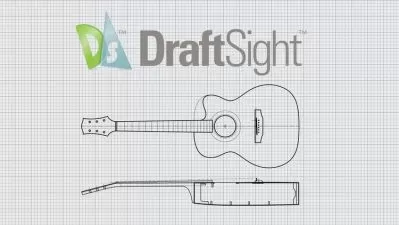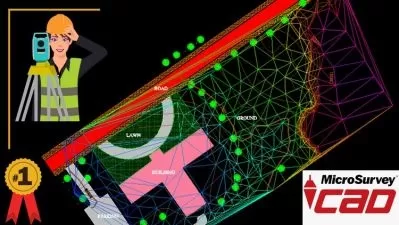5 MW NREL Wind Turbine CAD modeling
Sijal Ahmed
1:19:08
Description
Accurate and detailed CAD design of wind turbines.
What You'll Learn?
- Students will be proficient in using SolidWorks to create detailed and accurate 3D models of the 5 MW NREL wind turbine
- Students will understand the key engineering principles and design considerations specific to wind turbines
- Students will be able to apply industry standards and best practices in wind turbine design to ensure that their CAD models meet real-world performance
- Students will be adept at preparing and optimizing SolidWorks CAD models for CFD simulations, ensuring accurate and efficient meshing
Who is this for?
What You Need to Know?
More details
DescriptionWind turbines are essential for harnessing wind power to generate electricity, making a significant contribution to today’s renewable energy landscape. In 2023, global energy consumption reached 1.7×10^15 kWh (620 ExaJoules), with wind energy accounting for approximately 2.3×10^12 kWh, or around 7.81% of global electricity production. The Global Wind Energy Council (GWEC) forecasts that wind power will generate 20% of the world’s electricity by 2030. Denmark is a notable example, producing 58% of its electricity from wind power in 2023.
To meet this ambitious target, it is crucial to design larger and more efficient wind turbines. While both onshore and offshore wind turbines are used, offshore turbines are generally more efficient due to higher wind speeds, more consistent wind conditions, and the absence of obstacles present in onshore environments. Additionally, offshore turbines benefit from more available surface area and can support larger structures. Buoyancy forces also play an important role in the design and stability of these turbines.
In this course, students will learn to create an accurate CAD model of the 5 MW NREL wind turbine. Using the Dutch Offshore Wind Energy Converter (DOWEC) 6 MW turbine as a reference, which was scaled by NREL to develop the 5 MW baseline model, students will gain hands-on experience in wind turbine design. They will acquire skills in obtaining precise data and describing the aerodynamic properties of the turbine at various span/radial locations. By the end of the course, students will be proficient in modeling wind turbines in SolidWorks and will be prepared to use their CAD models for subsequent CFD simulations.
Who this course is for:
- Undergraduate or graduate students in mechanical engineering, aerospace engineering, or related fields who are seeking to enhance their skills in CAD modeling and CFD analysis.
- Engineers working in the renewable energy sector or those involved in mechanical design who wish to gain advanced skills in CAD modeling for wind turbines.
- Individuals specializing in mechanical design, simulation, or computational analysis who want to deepen their knowledge of wind turbine modeling and performance analysis.
- Individuals interested in renewable energy technologies, specifically wind power, who seek practical skills in CAD modeling and simulation.
Wind turbines are essential for harnessing wind power to generate electricity, making a significant contribution to today’s renewable energy landscape. In 2023, global energy consumption reached 1.7×10^15 kWh (620 ExaJoules), with wind energy accounting for approximately 2.3×10^12 kWh, or around 7.81% of global electricity production. The Global Wind Energy Council (GWEC) forecasts that wind power will generate 20% of the world’s electricity by 2030. Denmark is a notable example, producing 58% of its electricity from wind power in 2023.
To meet this ambitious target, it is crucial to design larger and more efficient wind turbines. While both onshore and offshore wind turbines are used, offshore turbines are generally more efficient due to higher wind speeds, more consistent wind conditions, and the absence of obstacles present in onshore environments. Additionally, offshore turbines benefit from more available surface area and can support larger structures. Buoyancy forces also play an important role in the design and stability of these turbines.
In this course, students will learn to create an accurate CAD model of the 5 MW NREL wind turbine. Using the Dutch Offshore Wind Energy Converter (DOWEC) 6 MW turbine as a reference, which was scaled by NREL to develop the 5 MW baseline model, students will gain hands-on experience in wind turbine design. They will acquire skills in obtaining precise data and describing the aerodynamic properties of the turbine at various span/radial locations. By the end of the course, students will be proficient in modeling wind turbines in SolidWorks and will be prepared to use their CAD models for subsequent CFD simulations.
Who this course is for:
- Undergraduate or graduate students in mechanical engineering, aerospace engineering, or related fields who are seeking to enhance their skills in CAD modeling and CFD analysis.
- Engineers working in the renewable energy sector or those involved in mechanical design who wish to gain advanced skills in CAD modeling for wind turbines.
- Individuals specializing in mechanical design, simulation, or computational analysis who want to deepen their knowledge of wind turbine modeling and performance analysis.
- Individuals interested in renewable energy technologies, specifically wind power, who seek practical skills in CAD modeling and simulation.
User Reviews
Rating
Sijal Ahmed
Instructor's Courses
Udemy
View courses Udemy- language english
- Training sessions 5
- duration 1:19:08
- Release Date 2025/01/16











